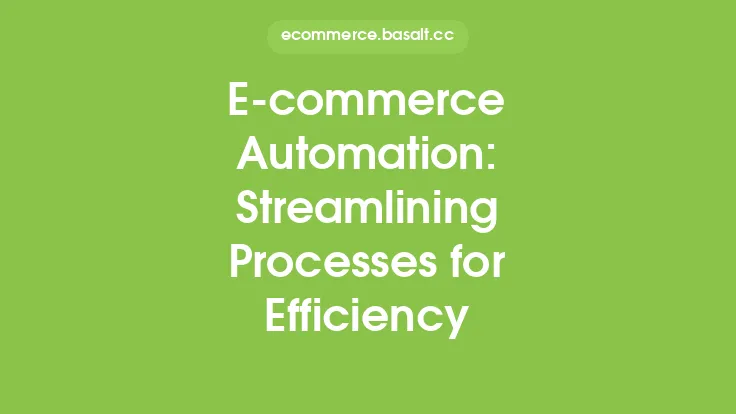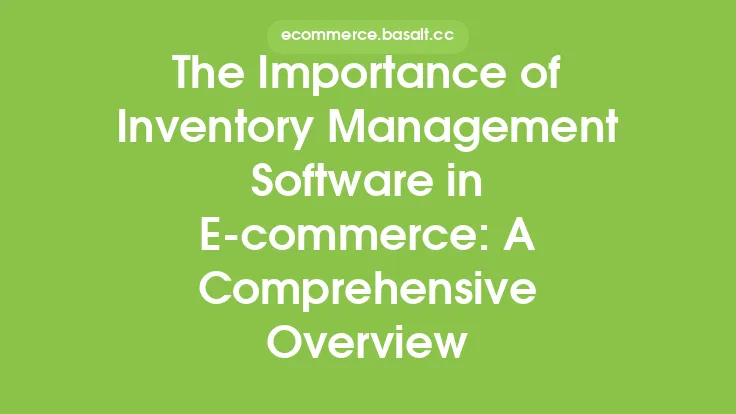In the fast-paced world of e-commerce, efficiency is key to staying ahead of the competition. With the rise of online shopping, businesses are under pressure to deliver high-quality products and services quickly and reliably. One way to achieve this is through workflow automation, which involves using technology to streamline and automate repetitive tasks and processes. By automating workflows, e-commerce businesses can unlock a range of benefits that can help them to improve productivity, reduce costs, and enhance the customer experience.
What is Workflow Automation?
Workflow automation refers to the use of software and technology to automate and streamline business processes. In the context of e-commerce, this can include tasks such as order processing, inventory management, shipping and fulfillment, and customer service. By automating these tasks, businesses can reduce the risk of human error, increase efficiency, and free up staff to focus on higher-value tasks. Workflow automation can be achieved through a range of tools and technologies, including robotic process automation (RPA), business process management (BPM) software, and integration platform as a service (iPaaS).
Benefits of Workflow Automation
The benefits of workflow automation in e-commerce are numerous. Some of the most significant advantages include:
- Increased efficiency: By automating repetitive tasks, businesses can process orders and fulfill shipments more quickly, which can help to improve customer satisfaction and reduce the risk of delays.
- Reduced costs: Automation can help to reduce labor costs by minimizing the need for manual intervention. It can also help to reduce errors and exceptions, which can be costly to resolve.
- Improved accuracy: Automated workflows can help to reduce the risk of human error, which can lead to mistakes and delays.
- Enhanced customer experience: By automating tasks such as order tracking and shipping notifications, businesses can provide customers with real-time updates and improve the overall shopping experience.
- Scalability: Automated workflows can help businesses to scale more easily, as they can handle increased volumes of orders and traffic without the need for significant additional resources.
Key Areas for Automation
There are several key areas where automation can have a significant impact in e-commerce. These include:
- Order processing: Automating order processing can help to reduce the risk of errors and delays, and ensure that orders are fulfilled quickly and efficiently.
- Inventory management: Automated inventory management can help businesses to keep track of stock levels, reduce the risk of overstocking or understocking, and optimize inventory levels.
- Shipping and fulfillment: Automating shipping and fulfillment can help businesses to reduce costs, improve delivery times, and enhance the customer experience.
- Customer service: Automated customer service tools, such as chatbots and email automation, can help businesses to provide 24/7 support and improve response times.
Best Practices for Implementing Workflow Automation
To get the most out of workflow automation, businesses should follow some best practices. These include:
- Identifying areas for automation: Businesses should start by identifying areas where automation can have the greatest impact, such as order processing or inventory management.
- Choosing the right tools: Businesses should choose automation tools that are tailored to their specific needs and integrate with their existing systems.
- Testing and piloting: Businesses should test and pilot automated workflows before rolling them out across the organization.
- Monitoring and evaluating: Businesses should continuously monitor and evaluate automated workflows to ensure they are working effectively and making adjustments as needed.
Common Challenges and Limitations
While workflow automation can have numerous benefits, there are also some common challenges and limitations to be aware of. These include:
- Integration with existing systems: Automated workflows may require integration with existing systems, which can be time-consuming and costly.
- Data quality: Automated workflows are only as good as the data they are based on, so businesses must ensure that their data is accurate and up-to-date.
- Change management: Implementing automated workflows can require significant changes to business processes and may require staff training and support.
- Security and compliance: Automated workflows must be designed with security and compliance in mind, to ensure that sensitive data is protected and regulatory requirements are met.
Future of Workflow Automation
The future of workflow automation in e-commerce is exciting and rapidly evolving. Some of the key trends to watch include:
- Artificial intelligence (AI) and machine learning (ML): AI and ML are being used to enhance automated workflows, enabling businesses to make predictions, identify patterns, and optimize processes.
- Internet of Things (IoT): The IoT is enabling businesses to automate workflows in new and innovative ways, such as using sensors and devices to track inventory levels and optimize supply chains.
- Cloud-based automation: Cloud-based automation platforms are making it easier for businesses to implement and manage automated workflows, without the need for significant upfront investment.
- Low-code and no-code automation: Low-code and no-code automation platforms are enabling businesses to automate workflows without the need for extensive coding or technical expertise.
Conclusion
Workflow automation is a powerful tool for e-commerce businesses, enabling them to unlock efficiency, reduce costs, and enhance the customer experience. By understanding the benefits and best practices of workflow automation, businesses can start to implement automated workflows that drive real results. Whether it's automating order processing, inventory management, or customer service, the potential for workflow automation in e-commerce is vast and exciting. As the technology continues to evolve, we can expect to see even more innovative applications of workflow automation in the years to come.





